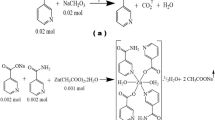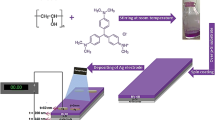Abstract
The RuO2-doped organic polymer composite structure was used as the interface to study the photodiode properties of a Schottky structure. Some basic electrical and optoelectrical parameters of the structure interlaid with RuO2:PVC were investigated using the I–V characteristics in the dark and under definite illuminations. The values of saturation current (I0), barrier height (ΦB0) at zero-bias, ideality factor (n), series and shunt resistances (Rs and Rsh) were calculated by using different methods such as thermionic emission, Ohm’s law, Cheung and Norde functions. They were found to be intensely depend on illumination levels and voltage. Forward bias I–V data were used to obtain energy-dependent profiles of interface-states (Nss) for each illumination level. Moreover, the open-circuit voltage (Voc), short circuit current (Isc), filling factor (FF), and efficiency (η) of the fabricated Schottky structure were found as 0.118 V, 6.4 μA, 46%, and 0.088% under 50 mW/cm−2, respectively. According to the findings, the RuO2:PVC organic interlayer is light-sensitive and can thus be used in optoelectronic applications, such as photodetectors and photodiodes.
Graphical abstract













Similar content being viewed by others
References
Yakuphanoglu F (2010) Controlling of silicon–insulator–metal junction by organic semiconductor polymer thin film. Synth Met 160:1551–1555. https://doi.org/10.1016/j.synthmet.2010.05.024
Tataroğlu A, Altındal Ş, Azizian-Kalandaragh Y (2020) Comparison of electrical properties of MS and MPS type diode in respect of (In2O3-PVP) interlayer. Physica B Condens Matter 576:411733. https://doi.org/10.1016/j.physb.2019.411733
Tataroğlu A, Dayan O, Özdemir N et al (2016) Single crystal ruthenium(II) complex dye based photodiode. Dyes Pigm 132:64–71. https://doi.org/10.1016/j.dyepig.2016.04.044
Khalili S, Chenari HM, Yıldırım F et al (2021) Highly sensitive, self-powered photodetector based on reduced graphene oxide- polyvinyl pyrrolidone fibers (Fs)/p-Si heterojunction. J Alloys Compd 889:161647. https://doi.org/10.1016/j.jallcom.2021.161647
Tozlu C, Mutlu A (2016) Poly(melamine-co-formaldehyde) methylated effect on the interface states of metal/polymer/p-Si Schottky barrier diode. Synth Met 211:99–106. https://doi.org/10.1016/j.synthmet.2015.11.023
Siva Pratap Reddy M, Sreenu K, Rajagopal Reddy V, Park C (2017) Modified electrical properties and transport mechanism of Ti/p-InP Schottky structure with a polyvinylpyrrolidone (PVP) polymer interlayer. J Mater Sci Mater Electron 28:4847–4855. https://doi.org/10.1007/s10854-016-6131-8
Padma R, Sreenu K, Rajagopal Reddy V (2017) Electrical and frequency dependence characteristics of Ti/polyethylene oxide (PEO)/p-type InP organic-inorganic Schottky junction. J Alloys Compd 695:2587–2596. https://doi.org/10.1016/j.jallcom.2016.11.165
Siva Pratap Reddy M, Lee J-H, Jang J-S (2013) Frequency dependent series resistance and interface states in Au/bio-organic/n-GaN Schottky structures based on DNA biopolymer. Synth Met 185–186:167–171. https://doi.org/10.1016/j.synthmet.2013.10.012
Ulusoy M, Altındal Ş, Azizian-Kalandaragh Y et al (2022) The electrical characteristic of an MIS structure with biocompatible minerals doped (Brushite+Monetite: PVC) interface layer. Microelectron Eng 258:111768. https://doi.org/10.1016/J.MEE.2022.111768
Skotheim TA, Reynolds J (2007) Handbook of conducting Polymers, vol 2. CRC Press
Tecimer H, Tan SO, Altindal S (2018) Frequency-dependent admittance analysis of the metal-semiconductor structure with an interlayer of zn-doped organic polymer nanocomposites. IEEE Trans Electron Devices. https://doi.org/10.1109/TED.2017.2778023
Wang L, Zhang L, Tian M (2012) Improved polyvinylpyrrolidone (PVP)/graphite nanocomposites by solution compounding and spray drying. Polym Adv Technol. https://doi.org/10.1002/pat.1940
Yu J, Sun L, Ma C et al (2016) Thermal degradation of PVC: a review. Waste Manage 48:300–314. https://doi.org/10.1016/j.wasman.2015.11.041
Uma T, Mahalingam T, Stimming U (2005) Solid polymer electrolytes based on poly(vinylchloride)–lithium sulfate. Mater Chem Phys 90:239–244. https://doi.org/10.1016/j.matchemphys.2003.11.010
Iván B (1996) Thermal Stability, Degradation, and Stabilization Mechanisms of Poly(vinyl chloride), pp 19–32
Braun D (2001) PVC - origin, growth, and future. J Vinyl Add Tech 7:168–176. https://doi.org/10.1002/vnl.10288
Starns WH, Edelson D (1979) Mechanistic aspects of the behavior of molybdenum (vi) oxide as a fire-retardant additive for poly (vinyl chloride). An Interpret Rev Macromol 12:797–802
Meyer J, Hamwi S, Kröger M et al (2012) Transition metal oxides for organic electronics: energetics, device physics and applications. Adv Mater 24:5408–5427. https://doi.org/10.1002/adma.201201630
Meyer J, Kröger M, Hamwi S et al (2010) Charge generation layers comprising transition metal-oxide/organic interfaces: electronic structure and charge generation mechanism. Appl Phys Lett 96:193302. https://doi.org/10.1063/1.3427430
Marschall R, Wang L (2014) Non-metal doping of transition metal oxides for visible-light photocatalysis. Catal Today 225:111–135. https://doi.org/10.1016/j.cattod.2013.10.088
Haque F, Daeneke T, Kalantar-zadeh K, Ou JZ (2018) Two-dimensional transition metal oxide and chalcogenide-based photocatalysts. Nanomicro Lett 10:23. https://doi.org/10.1007/s40820-017-0176-y
Batzill M (2011) Fundamental aspects of surface engineering of transition metal oxide photocatalysts. Energy Environ Sci 4:3275. https://doi.org/10.1039/c1ee01577j
Chen D, Zhang H, Liu Y, Li J (2013) Graphene and its derivatives for the development of solar cells, photoelectrochemical, and photocatalytic applications. Energy Environ Sci 6:1362. https://doi.org/10.1039/c3ee23586f
Dai B, Biesold GM, Zhang M et al (2021) Piezo-phototronic effect on photocatalysis, solar cells, photodetectors and light-emitting diodes. Chem Soc Rev 50:13646–13691. https://doi.org/10.1039/D1CS00506E
Devadas A, Baranton S, Napporn TW, Coutanceau C (2011) Tailoring of RuO2 nanoparticles by microwave assisted “Instant method” for energy storage applications. J Power Sources 196:4044–4053. https://doi.org/10.1016/j.jpowsour.2010.11.149
Mehtougui N, Rached D, Khenata R et al (2012) Structural, electronic and mechanical properties of RuO2 from first-principles calculations. Mater Sci Semicond Process 15:331–339. https://doi.org/10.1016/j.mssp.2012.02.001
de Almeida JS, Ahuja R (2006) Electronic and optical properties of RuO2 and IrO2. Phys Rev B 73:165102. https://doi.org/10.1103/PhysRevB.73.165102
Altındal Ş, Azizian-Kalandaragh Y, Ulusoy M, Pirgholi-Givi G (2022) The illumination effects on the current conduction mechanisms of the Au/( <scp> Er 2 O 3 </scp> : <scp>PVC</scp> )/ <scp>n-Si</scp> ( <scp>MPS</scp> ) Schottky diodes. J Appl Polym Sci. https://doi.org/10.1002/app.52497
Elamen H, Badali Y, Güneşer MT, Altındal Ş (2020) The possible current-conduction mechanism in the Au/(CoSO4-PVP)/n-Si junctions. J Mater Sci Mater Electron 31:18640–18648. https://doi.org/10.1007/s10854-020-04406-3
Nawar AM, Abd-Elsalam M, El-Mahalawy AM, El-Nahass MM (2020) Analyzed electrical performance and induced interface passivation of fabricated Al/NTCDA/p-Si MIS–Schottky heterojunction. Appl Phys A 126:113. https://doi.org/10.1007/s00339-020-3289-y
Li SS (1988) Metal-Semiconductor Contacts. Semiconductor Physical Electronics. Springer, New York, New York, NY, pp 284–333
Rani N, Chahal S, Chauhan AS et al (2019) X-ray Analysis of MgO Nanoparticles by Modified Scherer’s Williamson-Hall and Size-Strain Method. Mater Today Proc 12:543–548. https://doi.org/10.1016/j.matpr.2019.03.096
Reichman J (1980) The current-voltage characteristics of semiconductor-electrolyte junction photovoltaic cells. Appl Phys Lett 36:574–577. https://doi.org/10.1063/1.91551
Zhang M, Irfan DH et al (2010) Organic Schottky barrier photovoltaic cells based on MoOx/C60. Appl Phys Lett 96:183301. https://doi.org/10.1063/1.3415497
McVay E, Zubair A, Lin Y et al (2020) Impact of Al2O3 passivation on the photovoltaic performance of vertical wse2 schottky junction solar Cells. ACS Appl Mater Interfaces 12:57987–57995. https://doi.org/10.1021/acsami.0c15573
Sharma BL (1984) Metal-semiconductor Schottky barrier junctions and their applications. Springer, US, Boston, MA
Rhoderick EH, Williams RH (1988) Metal-semiconductor contacts, 2nd edn. Clarendon Press, New York
Demirezen S (2019) The role of interface traps, series resistance and (Ni-doped PVA) interlayer effects on electrical characteristics in Al/p-Si (MS) structures. J Mater Sci: Mater Electron 30:19854–19861. https://doi.org/10.1007/s10854-019-02352-3
Zhou Q, Wu H, Li H et al (2019) Barrier inhomogeneity of schottky diode on nonpolar ALN grown by physical vapor transport. IEEE J Electron Devices Soc 7:662–667. https://doi.org/10.1109/JEDS.2019.2923204
Buyukbas Ulusan A, Tataroglu A (2018) Analysis of barrier inhomogeneities in AuGe/n-Ge Schottky diode. Indian J Phys 92:1397–1402. https://doi.org/10.1007/s12648-018-1240-2
Jagani HS, Gupta SU, Bhoraniya K et al (2022) Photosensitive Schottky barrier diodes based on Cu/p-SnSe thin films fabricated by thermal evaporation. Mater Adv 3:2425–2433. https://doi.org/10.1039/D1MA01005K
Sze SM, Ng KK (2006) Physics of semiconductor devices, 3rd edn. John Wiley & Sons Inc, Hoboken
Rose A (1978) Concepts in photoconductivity and allied problems. Krieger, New York
Gupta RK, Yakuphanoglu F (2012) Photoconductive Schottky diode based on Al/p–Si/SnS2/Ag for optical sensor applications. Sol Energy 86:1539–1545. https://doi.org/10.1016/j.solener.2012.02.015
Grimmeiss HG (1993) Photoelectronic properties of semiconductors. By Richard H. Bube , cambridge university press, cambridge 1992, 318 pp., paperback, £ 17.95, ISBN 0-521-40681-1. Adv Mater 5:65–66. https://doi.org/10.1002/adma.19930050120
Yakuphanoglu F, Aslam Farooq W (2011) Photoresponse and electrical characterization of photodiode based nanofibers ZnO and Si. Mater Sci Semicond Process 14:207–211. https://doi.org/10.1016/j.mssp.2011.02.017
Ulusan AB, Tataroglu A, Altındal Ş, Azizian-Kalandaragh Y (2021) Photoresponse characteristics of Au/(CoFe2O4-PVP)/n-Si/Au (MPS) diode. J Mater Sci Mater Electron 32:15732–15739. https://doi.org/10.1007/s10854-021-06124-w
Kaya FŞ, Duman S, Orak İ, Baris Ö (2021) Effect of illumination on the electrical characteristics of Au/n-GaP/Al and Au/Chlorophyll-a/n-GaP/Al structures. Mater Sci Eng B 265:114980. https://doi.org/10.1016/j.mseb.2020.114980
Kocyigit A, Yıldırım M, Kose DA, Yıldız DE (2022) Synthesize and characterization of Co-complex as interlayer for Schottky type photodiode. Polym Bull. https://doi.org/10.1007/s00289-021-04021-0
Norde H (1979) A modified forward I–V plot for Schottky diodes with high series resistance. J Appl Phys 50:5052–5053. https://doi.org/10.1063/1.325607
Cheung SK, Cheung NW (1986) Extraction of Schottky diode parameters from forward current-voltage characteristics. Appl Phys Lett 49:85–87. https://doi.org/10.1063/1.97359
Bohlin KE (1986) Generalized Norde plot including determination of the ideality factor. J Appl Phys 60:1223–1224. https://doi.org/10.1063/1.337372
Sharma M, Tripathi SK (2013) Analysis of interface states and series resistance for Al/PVA:n-CdS nanocomposite metal–semiconductor and metal–insulator–semiconductor diode structures. Appl Phys A 113:491–499. https://doi.org/10.1007/s00339-013-7552-3
Tecimer HU, Alper MA, Tecimer H et al (2018) Integration of Zn-doped organic polymer nanocomposites between metal semiconductor structure to reveal the electrical qualifications of the diodes. Polym Bull 75:4257–4271. https://doi.org/10.1007/s00289-018-2274-5
Card HC, Rhoderick EH (1971) Studies of tunnel MOS diodes I. interface effects in silicon Schottky diodes. J Phys D Appl Phys. https://doi.org/10.1088/0022-3727/4/10/319
Werner JH, Güttler HH (1991) Barrier inhomogeneities at schottky contacts. J Appl Phys 69:1522–1533. https://doi.org/10.1063/1.347243
Alialy S, Tecimer H, Uslu H, Altındal Ş (2017) A comparative study on electrical characteristics of Au/N-Si Schottky Diodes, with and Without Bi-Doped PVA interfacial layer in dark and under illumination at room temperature. J Nanomed Nanotechnol. https://doi.org/10.4172/2157-7439.1000167
Demirezen S, Altındal Yerişkin S (2020) A detailed comparative study on electrical and photovoltaic characteristics of Al/p-Si photodiodes with coumarin-doped PVA interfacial layer: the effect of doping concentration. Polym Bull 77:49–71. https://doi.org/10.1007/s00289-019-02704-3
Acknowledgements
This study was supported by Gazi University Scientific Research Project. (Project Number: GU-BAP.05/2019-26)
Author information
Authors and Affiliations
Contributions
All authors contributed approximately the same to the preparation of the samples and their interpretation and writing.
Corresponding author
Ethics declarations
Conflict of interest
The authors have no relevant financial or non-financial interests to disclose.
Additional information
Publisher's Note
Springer Nature remains neutral with regard to jurisdictional claims in published maps and institutional affiliations.
Rights and permissions
Springer Nature or its licensor (e.g. a society or other partner) holds exclusive rights to this article under a publishing agreement with the author(s) or other rightsholder(s); author self-archiving of the accepted manuscript version of this article is solely governed by the terms of such publishing agreement and applicable law.
About this article
Cite this article
Elamen, H., Badali, Y., Ulusoy, M. et al. The photoresponse behavior of a Schottky structure with a transition metal oxide-doped organic polymer (RuO2:PVC) interface. Polym. Bull. 81, 403–422 (2024). https://doi.org/10.1007/s00289-023-04725-5
Received:
Revised:
Accepted:
Published:
Issue Date:
DOI: https://doi.org/10.1007/s00289-023-04725-5




